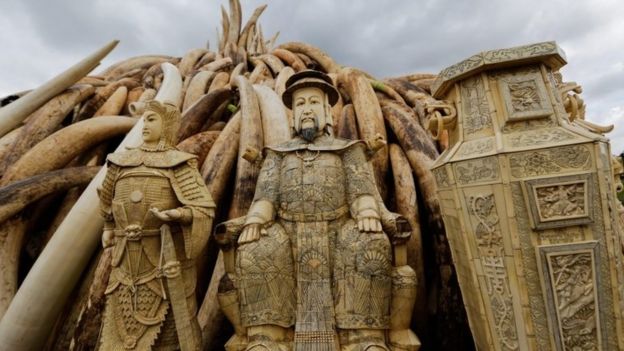- 3 hours ago
- Africa
Kenyan President Uhuru Kenyatta has set fire to a huge stockpile of ivory in an effort to show his country's commitment to saving Africa's elephants.
More than 100 tonnes of ivory was stacked up in pyres in Nairobi National Park where it is expected to burn for several days.
The ivory represents nearly the entire stock confiscated by Kenya, amounting to the tusks of about 6,700 elephants.
Some disagree with Kenya's approach, saying it can encourage poaching.
Before igniting the first pyre, Mr Kenyatta said: "The height of the pile of ivory before us marks the strength of our resolve.
"No-one, and I repeat no-one, has any business in trading in ivory, for this trade means death of our elephants and death of our natural heritage."
The burning comes after African leaders meeting in Kenya urged an end to illegal trade in ivory.
Experts have warned Africa's elephants could be extinct within decades.
But some conservationists have expressed opposition to the ivory burn in Kenya, the biggest in history.
They say destroying so much of a rare commodity could increase its value and encourage more poaching rather than less.
Botswana, which is home to about half of Africa's elephants, is opposed to the burn and its president did not attend the event in Nairobi.
Demand for ivory comes largely from Asia, with the main trafficking route being through the Kenyan port of Mombasa.
The war on elephants, by Alastair Leithead, BBC News
 Reuters
Reuters
The ivory is getting through because people are prepared to pay for it. Stopping the men with arrows and the corrupt officials is just one part of the solution - the other is destroying the hunger for ivory.
The love of ivory goes back millennia. Its pure, translucent beauty and the ease with which a tusk can be carved into intricate sculptures have given it a lasting value throughout the ages.
Tackling demand and destroying the market are both important but there are also ways of making elephants more valuable alive than dead.
In the parks and game reserves of Africa, close encounters with the most remarkable animals on the planet lie in wait - you just need time, patience and a good eye.
 EPA
EPAThe African push to tackle ivory poaching, by BBC Monitoring
- Kenya is struggling with poaching, and tough laws with huge fines and prison sentences do not seem to be a deterrent. Kenya Wildlife Service says it suffers from staff and equipment shortages.
- Uganda is a conservation success story. Elephant populations have increased to around 5,000 after reaching a low of 700 in the 1980s. Kampala has set up a wildlife crime unit, and plans cross-border programmes with its neighbours.
- Gabon uses paratroops to crack down on poachers who target elephants living in dense equatorial forests. The wildlife service has expanded 10-fold to over 650 guards with a much-increased budget.
- Botswana adopted a shoot-to-kill policy in December 2013 in an effort to curb elephant poaching. It also placed a total ban on hunting in 2014 which extends to all animal species.
- Tanzania's government has increased routine patrols, netting over 1,000 suspected poachers by the end of 2015.
Africa is home to between 450,000 and 500,000 elephants but more than 30,000 are killed every year for their tusks. Tanzania has lost 65% of its elephant population in the past five years.
The Kenyan ivory pyres are seven times the size of any stockpile destruction so far, and represent about 5% of global ivory stores.
Some 1.35 tonnes of rhino horn will also be burned.
The street value of the ivory to be destroyed is estimated at more than $100m (£70m), and the rhino horn at $80m.
"We don't believe there is any intrinsic value in ivory, and therefore we're going to burn all our stockpiles and demonstrate to the world that ivory is only valuable on elephants," said Kitili Mbathi, director general of the Kenya Wildlife Service.

No comments:
Post a Comment